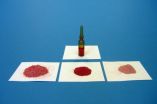(Press-News.org) EAST LANSING, Mich. — In a major breakthrough that comes after decades of research and nearly half a billion treatments in humans, scientists have finally unlocked how a key anti-parasitic drug kills the worms brought on by the filarial diseases river blindness and elephantitis.
Understanding how the drug ivermectin works has the potential to lead to new treatments for the diseases, in which the body is infected with parasitic worms, said Charles Mackenzie, a professor of veterinary pathology in the College of Veterinary Medicine and researcher on the project. The diseases afflict about 140 million people worldwide, doing much of their damage in equatorial Africa.
"Ivermectin is one of the most important veterinary and human anti-parasitic agents ever," Mackenzie said. "Knowing specifically how it interacts with the body's own immune system and kills parasitic worms opens up whole new treatment avenues."
The research appears in the current edition of the Proceedings of the National Academy of Sciences.
Elephantiasis (lymphatic filariasis) is caused by tiny worms spread via mosquitoes and results in severe swelling of the legs, arms and torso. River blindness (onchocerciasis) is spread by black flies, and after the worms die in a person's eye, they can cause blindness and debilitating skin disease.
Ivermectin works by killing the first stage of the worm in the human body, and also appears to paralyze the reproductive tract of the adult female worms, stopping reproduction of new parasites.
What the researchers discovered is that the drug does this by preventing the worm from secreting proteins through a pore in its mid-body; ivermectin binds to receptors at the pore and blocks the secretions. It is the secretions that normally block a person's ability to attack and kill the worm; after the drug prevents them, the host's own immune system is able to attack and kill the parasites.
"Understanding how the worms were avoiding the host's immune responses will greatly enhance our ability to manipulate the immune system to the advantage of the host, and perhaps develop vaccines," Mackenzie said. "Also, one of the most important challenges in the overall effort against filarial infections relates to the development of resistance and the loss of efficacy of the drugs we use; this new knowledge provides an important key to understanding and perhaps preventing resistance."
Ivermectin was developed by pharmaceutical firm Merck & Co. in the 1970s from a soil fungus. It was donated in 1987 for use to treat river blindness, as existing drugs were in fact inducing blindness. Ivermectin was able to be used safely in mass drug administration programs in many developing countries, shifting the paradigm for how public health programs delivered medicines in rural areas. The drug then was used in other parasitic disease programs, such as the one for elephantiasis, treating more than 100 million people for that disease.
Mackenzie has worked for more than 20 years on tropical filarial diseases, much of that time partnering with Tim Geary at McGill University in Montreal. Geary's lab was critical in the ivermectin findings, as was McGill graduate student Yovany Moreno. Geary and Mackenzie also recently were awarded $2 million from the Gates Foundation to study another anti-filarial drug, flubendazole.
INFORMATION:
Michigan State University has been advancing knowledge and transforming lives through innovative teaching, research and outreach for more than 150 years. MSU is known internationally as a major public university with global reach and extraordinary impact. Its 17 degree-granting colleges attract scholars worldwide who are interested in combining education with practical problem solving.
Researchers unlock how key drug kills tropical parasites
Discovery could lead to new treatments for filarial diseases
2010-11-11
ELSE PRESS RELEASES FROM THIS DATE:
Potential hemlock hybrids tolerant to invasive hemlock woolly adelgid
2010-11-11
New hemlock hybrids that are tolerant to the invasive insect known as hemlock woolly adelgid have been created by U.S. Department of Agriculture (USDA) scientists.
Geneticist Richard Olsen and horticulturist Sue Bentz of USDA's Agricultural Research Service (ARS) teamed up with Forest Service entomologist Mike Montgomery to breed and select these tolerant hybrids. Olsen and Bentz work in the U.S. National Arboretum's Floral and Nursery Plants Research Unit in Beltsville, Md. The arboretum is located in Washington, D.C., and is operated by ARS, the principal intramural ...
By reducing disease risk, 'Desktop Medicine' will transform the practice of medicine
2010-11-11
Gone are the days when a doctor's only way of helping patients is by treating the disease after symptoms have started. Instead, a new approach to medicine, called "Desktop Medicine" is emerging, in which the emphasis shifts from diagnosing diseases and treating symptoms to identifying risk-factors for medical conditions such as hypertension and osteoporosis, and intervening before they develop. The commentary appears in the current issue of the Journal of the American Medical Association.
"Desktop medicine," a model defined by Jason Karlawish, MD, Associate Professor ...
Bowel cancer: 8 years of colonoscopy screening in Germany -- a success story
2010-11-11
By the end of this year, colonoscopy screening will have prevented bowel cancer in approximately 99 000 people since it was introduced in Germany. This is the result obtained by Hermann Brenner of the German Cancer Research Center in Heidelberg and his co-authors in their interim assessment conducted eight years after the procedure was added to the German cancer screening program. The authors present their projection and initial results of colonoscopy screening in Germany in the current edition of Deutsches Ärzteblatt International (Dtsch Arztebl Int 2010: 107(43): 753 ...
Updated NIST software uses combination testing to catch bugs fast and easy
2010-11-11
Researchers at the National Institute of Standards and Technology (NIST) have released an updated version of a computer system testing tool that can cut costs by more efficiently finding flaws. A tutorial on using the tool accompanies the new release.
Catching software "bugs" before a program is released enhances computer security because hackers often exploit these flaws to introduce malware, including viruses, to disrupt or take control of computer systems. But it's difficult. A widely cited 2002 study prepared for NIST* reported that even though 50 percent of software ...
U of M researchers find learning in the visual brain
2010-11-11
A team of researchers from the University of Minnesota's College of Liberal Arts and College of Science and Engineering have found that an early part of the brain's visual system rewires itself when people are trained to perceive patterns, and have shown for the first time that this neural learning appears to be independent of higher order conscious visual processing.
The researchers' findings could help shape training programs for people who must learn to detect subtle patterns quickly, such as doctors reading X-rays or air traffic controllers monitoring radars. In addition, ...
New NIST dietary supplement reference materials could be 'berry' useful
2010-11-11
National Institute of Standards and Technology (NIST) researchers have developed new certified reference materials for measuring amounts of organic acids in dietary supplements formulated with Vaccinium berries—cranberries, blueberries and bilberries. As described in a recent paper,* manufacturers and researchers can use this new suite of standard reference materialsTM (SRMs) as quality assurance tools.
berry SRMs
Dietary supplement manufacturers often include health claims on products made with Vaccinium berries. Suggested benefits include prevention of urinary tract ...
Academies of science call for amendments to impracticable Genetic Diagnostics Act
2010-11-11
Many aspects of the German Genetic Diagnostics Act (Gendiagnostikgesetz) are out of touch with the latest technology, almost impossible to implement in clinical practice, or even detrimental to the success of recognised screening tests, such as newborn screening. The Act, which came into force in February 2010, is in desperate need of amendment. This was the conclusion reached by the Academy Workgroup "Predictive genetic diagnostics as an instrument of disease prevention" of the German Academy of Sciences Leopoldina, the Berlin-Brandenburg Academy of Sciences and Humanities ...
NIST pings key material in sonar, closes gap on structural mystery
2010-11-11
Using a neutron beam as a probe, researchers working at the National Institute of Standards and Technology (NIST) have begun to reveal the crystal structure of a compound essential to technologies ranging from sonar to computer memory. Their recent work* provides long-sought insight into just how a widely used material of modern technology actually works.
The compound is a "piezoelectric," a material capable of changing one kind of energy into another—mechanical to electrical, or vice versa. Long employed in sonar systems to detect sound waves, more recently piezoelectrics ...
Looking for wireless? Try a local farm
2010-11-11
VIDEO:
Wireless. For most, the word conjures images quaint coffee shops or busy airport lobbies -- places where people drop in to check on business or check in with other people.
But...
Click here for more information.
BEAUMONT – Wireless. For most, the word conjures images quaint coffee shops or busy airport lobbies – places where people drop in to check on business or check in with other people.
But increasingly "wireless" is showing up on the farm to help produce better ...
AFM positioning: Shining light on a needle in a haystack
2010-11-11
The researchers characterize their new technique as a neat solution to the "needle in a haystack" problem of nanoscale microscopy, but it's more like the difference between finding the coffee table in a darkened room either by walking around until you fall over it, or using a flashlight. In a new paper,* a group from JILA—a joint venture of the National Institute of Standards and Technology (NIST) and the University of Colorado—finds tiny assemblies of biomolecules for subsequent detailed imaging by combining precision laser optics with atomic force microscopy.
The ...
LAST 30 PRESS RELEASES:
Groundbreaking mapping: how many ghost particles all the Milky Way’s stars send towards Earth
JBNU researchers propose hierarchical porous copper nanosheet-based triboelectric nanogenerators
A high-protein diet can defeat cholera infection
A more accurate way of calculating the value of a healthy year of life
What causes some people’s gut microbes to produce high alcohol levels?
Global study reveals widespread burning of plastic for heating and cooking
MIT study shows pills that communicate from the stomach could improve medication adherence
Searching for the centromere: diversity in pathways key for cell division
Behind nature’s blueprints
Researchers search for why some people’s gut microbes produce high alcohol levels
Researchers find promising new way to boost the immune response to cancer
Coffee as a staining agent substitute in electron microscopy
Revealing the diversity of olfactory receptors in hagfish and its implications for early vertebrate evolution
Development of an ultrasonic sensor capable of cuffless, non-invasive blood pressure measurement
Longer treatment with medications for opioid use disorder is associated with greater probability of survival
Strategy over morality can help conservation campaigns reduce ivory demand, research shows
Rising temperatures reshape microbial carbon cycling during animal carcass decomposition in water
Achieving ultra-low-power explosive jumps via locust bio-hybrid muscle actuators
Plant-derived phenolic acids revive the power of tetracycline against drug-resistant bacteria
Cooperation: A costly affair in bacterial social behaviour?
Viruses in wastewater: Silent drivers of pollution removal and antibiotic resistance
Sub-iethal water disinfection may accelerate the spread of antibiotic resistance
Three in four new Australian moms struggle with body image
Post-stroke injection protects the brain in preclinical study
Cardiovascular risk score predicts multiple eye diseases
Health: estimated one in ten British adults used or interested in GLP-1 medications for weight loss
Exercise to treat depression yields similar results to therapy
Whooping cough vaccination for pregnant women strengthens babies’ immune system
Dramatic decline in new cases of orphanhood in Uganda driven by HIV treatment and prevention programs
Stopping weight loss drugs linked to weight regain and reversal of heart health markers
[Press-News.org] Researchers unlock how key drug kills tropical parasitesDiscovery could lead to new treatments for filarial diseases




